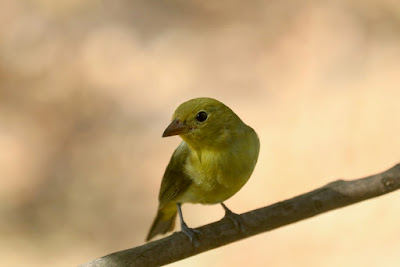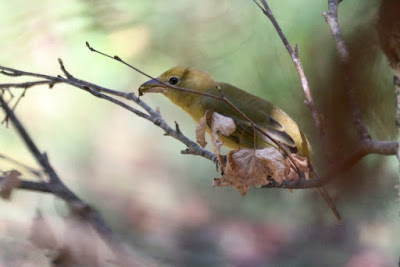I have huge dark Chamaecyparis trees hanging over my north studio windows. This is bad. It cuts my light. Gosh, they were so tiny when I planted them 30 years ago! Who'd think they'd shoot up to 20' plus, and get so thick and plumy? In desperation to get my view back I have limbed them up, but their bushy tops still cut a ton of light, especially on those dark winter days when the sun seems to set at 3 pm. Good times!
One of the good things about having huge dark Chamaecyparis trees hanging over my north studio windows, however, is the intimate look they give me into the lives of birds. They feel safe in those dark trees and they do things most people don’t get to see, right at eye level. It’s my mini canopy walk, I guess. I’m perched on my high drafting chair and they’re a good 12’ off the ground, and I’m looking right into their eyes. One of the more thrilling birds who perched in there was a Cooper's hawk, on April 6, 2023.
Most are songbirds, though, like this hatch-year female scarlet tanager who just calmly studied me as I looked back through the big lens. She was but a few feet away, and I was moving slowly, as always, so as not to frighten her. Sept. 16, 2024. My Canon is permanently to my left on the drawing table as I write or draw, and I've perfected a very fluid, slow way of hoisting it to my eye.

The water features, especially the trickling WarblerFall, draw in forest birds like nobody's business, especially during fall migration. Look at this gorgeous young male scarlet tanager molting into his first adult plumage on Sept. 16, 2024. He starts with the lesser coverts and will gradually replace the fresh flight feathers with jet black ones. And by next spring, he'll be replacing those green body feathers with brilliant scarlet ones.
I like how he looks like he's wearing a cape around his shoulders.
On Sept. 22, I was shocked to see a young male scarlet tanager eating a brown marmorated stinkbug, which would have to be the most odious mouthful a bird could ingest. But there he was, crunching it down like a toasted almond.
Maybe a little gag reflex happening here, but the bug went down the hatch. Zow!
The same day, I was thrilled to bits to see a young male summer tanager come in to drink at the WarblerFall, then perch in the Chamecyparis! Unlike the scarlet, summer tanagers don't breed on my land, though I do have the mix of Virginia pine and deciduous trees they seem to like.
Summer tanagers are a late summer and fall phenomenon here, and they are almost always hunting hymenopterans when they're here. I've had them catching yellowjackets off the deck railing!
Summer tanagers have an old folk name of "bee bird" because they are notorious for staking out beehives and feasting on their occupants, often catching them in air. My old friend Hank had one spend a Connecticut winter at his beehives in Old Lyme, living on honeybees. He was happy to donate bees, but he did offer other foods, hoping to cut the damage. This is where the extra long, strong beak of the summer tanager comes in really handy. It's good to distance your eyes and face from an angry bee, wasp or hornet.
This young bird was looking for something, and there was plenty of what he was looking for in my yard.
I have mentioned the absolute Jobian plague of yellowjackets that ruled my life and land all summer. I couldn't go anywhere without having to walk through swarms of yellowjackets, which spent the summer coursing low over the ground, looking for prey, and stinging me and Curtis. Curtis was stung nine times, and I was stung four times, and it was a huge drag. Yellowjacket stings hurt for a couple days and then itch for a week or more. I came to loathe those insects, which always seemed to be in between me and what I was trying to do. There were three huge ground nests in my backyard alone. In September, I accidentally mowed over a nest and got two yellowjackets down inside my hiking boots, stinging the blue-eyed crap out of me as I tried to stop the rider mower and slap them out of my socks. That was fun.
So I was thrilled to see the summer tanager chewin' on a yellowjacket in one of my birch trees.
He masticated that thing into a pulp before he swallowed it, stinger first. You want to make really sure the wasp's head is separated from its body before you pass it through your tender esophagus. Just looking at this photo hurts me, but that bird certainly knows what he's doing. Anyway, my theory as to why summer tanagers have evolved that big honkin' beak is to help them in their quest for stinging insects--an unexploited resource! They can quickly and safely process a large stinging insect with a long, strong beak. From seeing bees hit my windshield and leave a clear puddle of nectar, I imagine that they are sometimes quite sweet to eat, though I doubt I'll ever find out.
Score two tanagers and a couple cool sightings of Tanagers Eating Weird Stuff for the WarblerFall!
If you haven't got your plans yet, by all means go to
warblerfall.com and join the growing family of folks who know the magic attraction of moving water.
And remember, a WarblerFall makes a fabulous holiday gift. All you have to do is fill in your credit card info, and your recipient's email, and the plans will be emailed to your friend. You'll have to give them a heads up to look for it in their email.

Crazy cool bird sightings will follow! Thanks for your support.


















0 comments:
Post a Comment